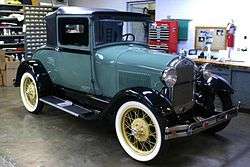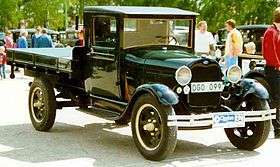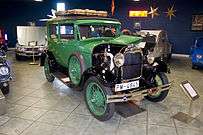Ford Model A (1927–31)
| Ford Model A | |
|---|---|
 1928 Ford Model A Tudor Sedan | |
| Overview | |
| Manufacturer | Ford Motor Company |
| Production | 1927–1931 |
| Assembly |
Chester, Pennsylvania Chicago, Illinois Dearborn, Michigan Jacksonville, Florida Long Beach, California Saint Paul, Minnesota Windsor, Ontario Buenos Aires, Argentina Santiago, Chile Cologne, Germany Yokohama, Japan Copenhagen, Denmark Cork, Ireland Trafford Park, England Geelong, Victoria Nizhny Novgorod, Russia |
| Body and chassis | |
| Class | Full-size Ford |
| Body style |
A – Chassis |
| Layout | FR layout |
| Platform | A Chassis |
| Related |
Ford Model AF Ford Model AA |
| Powertrain | |
| Engine | 201 CID (3.3 L) L-head-4 I4 |
| Transmission | 3-speed sliding gear manual |
| Dimensions | |
| Wheelbase | 103.5 in (2,629 mm)[1] |
| Length | 165 in (4,191 mm) |
| Width | 67 in (1,702 mm) |
| Curb weight | 2,265 lb (1,027 kg) |
| Chronology | |
| Predecessor | Ford Model T |
| Successor |
Ford Model B Ford Model 18 GAZ A GAZ-MM GAZ-AAA |
The Ford Model A (also colloquially called the A-Model Ford or the A, and A-bone among rodders and customizers),[2] was the second huge success for the Ford Motor Company, after its predecessor, the Model T. First produced on October 20, 1927, but not sold until December 2, it replaced the venerable Model T, which had been produced for 18 years. This new Model A (a previous model had used the name in 1903–04) was designated a 1928 model and was available in four standard colors.
By 4 February 1929, one million Model As had been sold, and by 24 July, two million.[3] The range of body styles ran from the Tudor at US$500 (in grey, green, or black)[3] to the Town Car with a dual cowl at US$1200.[4] In March 1930, Model A sales hit three million, and there were nine body styles available.[3]
Model A production ended in March, 1932, after 4,858,644 had been made in all body styles.[5] Its successor was the Model B, which featured an updated 4-cylinder engine, as well as the Model 18, which introduced Ford's new flathead (sidevalve) V8 engine.
Features
Prices for the Model A ranged from US$385 for a roadster to US$1400 for the top-of-the-line Town Car. The engine was a water-cooled L-head inline 4-cylinder with a displacement of 201 cu in (3.3 l).[6] This engine provided 40 hp (30 kW; 41 PS).[6] Top speed was around 65 mph (105 km/h). The Model A had a 103.5 in (2,630 mm) wheelbase with a final drive ratio of 3.77:1. The transmission was a conventional 3-speed sliding gear manual unsynchronized unit[6] with a single speed reverse. The Model A had 4-wheel mechanical drum brakes.[6] The 1930 and 1931 models were available with stainless steel radiator cowling and headlamp housings.
The Model A came in a wide variety of styles including a Coupe (Standard and Deluxe), the Business Coupe, Sport Coupe, Roadster Coupe (Standard and Deluxe), Convertible Cabriolet, Convertible Sedan, Phaeton (Standard and Deluxe), Tudor Sedan (Standard and Deluxe), Town Car, Fordor (2-window) (Standard and Deluxe), Fordor (3-window) (Standard and Deluxe), Victoria, Station Wagon, Taxicab, Truck, and Commercial. The very rare Special Coupe started production around March 1928 and ended mid-1929.
The Model A was the first Ford to use the standard set of driver controls with conventional clutch and brake pedals, throttle, and gearshift. Previous Fords used controls that had become uncommon to drivers of other makes. The Model A's fuel tank was situated in the cowl, between the engine compartment's fire wall and the dash panel. It had a visual fuel gauge, and the fuel flowed to the carburetor by gravity. A rear-view mirror was optional.[1] In cooler climates, owners could purchase an aftermarket cast iron unit to place over the exhaust manifold to provide heat to the cab. A small door provided adjustment of the amount of hot air entering the cab. The Model A was the first car to have safety glass in the windshield.[7]
The Soviet company GAZ, which started as a joint venture between Ford and the Soviet Union, made a licensed version 1932–1936.[8] This served as the basis for the FAI and BA-20 armored cars which saw use as Soviet scout vehicles in the early stages of World War II.
In addition to the United States, Ford made the Model A in plants in Argentina, Canada, Denmark, France, Germany, Japan and the United Kingdom.
In Europe, where in some countries cars were taxed according to engine size, Ford in the UK manufactured the Model A with a smaller displacement engine of 2043 cc providing a claimed output of 28 hp (21 kW; 28 PS).[9] However, the engine equated to a British fiscal horsepower of 14.9 hp (11.1 kW; 15.1 PS)[10] (compared to the 24 hp (18 kW; 24 PS) of the larger engine) and attracted a punitive annual car tax levy of £1 per fiscal hp in the UK . It therefore was expensive to own and too heavy and thirsty to achieve volume sales, and so unable to compete in the newly developing mass market, while also too crude to compete as a luxury product. European manufactured Model A's failed to achieve the sales success in Europe that would greet their smaller successor in England and Germany.[11]
Development history
From the mid 1910s through the early 1920s, Ford dominated the automotive market with its Model T. However, during the mid-1920s, this dominance eroded as competitors, especially the various General Motors divisions, caught up with Ford's mass production system and began to outcompete Ford in some areas, especially by offering more powerful engines, new convenience features, or cosmetic customization.[12][13][14] Also, features Henry Ford considered to be unnecessary, such as electric starters, were gradually shifting in the public's perception from luxuries to essentials.
Ford's sales force recognized the threat and advised Henry to respond to it. Initially he resisted, but the T's sagging market share finally forced him to admit a replacement was needed. When he finally agreed to begin development of this new model, he focused on the mechanical aspects and on what today is called design for manufacturability (DFM), which he had always strongly embraced and for which the Model T production system was famous. Although ultimately successful, the development of the Model A included many problems that had to be resolved.[15] For example, the die stamping of parts from sheet steel, which the Ford company had led to new heights of development with the Model T production system, was something Henry had always been ambivalent about; it had brought success, but he felt that it was not the best choice for durability. He was determined that the Model A would rely more on drop forgings than the Model T; but his ideas to improve the DFM of forging did not prove practical. Eventually, Ford's engineers persuaded him to relent, lest the Model A's production cost force up its retail price too much.[16]
Henry's disdain for cosmetic vanity as applied to automobiles led him to leave the Model A's styling to a team led by his son Edsel, even though he would take credit for it despite his son doing more of the work.
It was during the period from the mid-1920s to early 1930s that the limits of the first generation of mass production, epitomized by the Model T production system's rigidity, became apparent. The era of "flexible mass production" had begun.[17][18]
Film and media
The Model A was well represented in media of the era since it was one of the most common cars. Model kits are still available from hobby shops in the 2000s, as stock cars or hot rods.
Perhaps in reference to the remarkable upgrade from the previous Model T, a song was written about the Model A by Irving Kaufman called "Henry's Made a Lady Out Of Lizzie", a reference to the moniker Tin Lizzie given to the Model T.
Several Model As have obtained particular fame. The "Mean Green Machine", a green and black 1931 Tudor Sedan, has been a staple to University of North Texas football games and special events since 1974. It is taken care of/ driven by the spirit organization Talons since the 1980s. The Ramblin' Wreck, a 1930 Sport Coupe, is the official mascot of the student body at the Georgia Institute of Technology and appears at sporting events and student body functions. Ala Kart, a customized 1929 roadster pickup built by George Barris won two straight "America's Most Beautiful Roadster" awards at the Oakland Roadster Show before making numerous film and television appearances. Between October 1992 to December 1994, Hector Quevedo, along with his son Hugo, drove a 1928 Model A 22,000 mi (35,406 km) from his home in Punta Arenas, Chile to Ford headquarters in Dearborn, Michigan. The car required minimal service, including a flat tire and transmission work in Nicaragua, and is now housed in the Henry Ford Museum.[19]
Charlie Ryan's song "Hot Rod Lincoln" featured a Model A with a Lincoln flathead V12 and other modifications.
Gallery
| Example Model A Ford Automobiles | ||||||||||||||||||||||
|---|---|---|---|---|---|---|---|---|---|---|---|---|---|---|---|---|---|---|---|---|---|---|
|
References
- 1 2 Kimes, Beverly (1996). standard catalog of American Cars 1805-1942. Krause publications. ISBN 0-87341-428-4.
- ↑ Bianco, Johnny, "Leadfest" in Rod & Custom, 9/00, p. 86.
- 1 2 3 Gauld, p. 693.
- ↑ Gauld, p. 694.
- ↑ "Model A Production Figures". Model A Ford Club of America. Retrieved 2015-04-12.
- 1 2 3 4 Cheetham, Craig (2004). Vintage Cars - The Finest Prewar Automobiles. Rochester, United Kingdom: Grange Books. p. 31. ISBN 1840136359.
- ↑ "Directory Index: Ford/1930_Ford/1930_Ford_Brochure_02". Oldcarbrochures.com. Retrieved 2011-11-20.
- ↑ Sorensen 1956, pp. 206–208.
- ↑ Werner Oswald. Deutsche Autos 1920-1945 p. 416 ISBN 3-87943-519-7
- ↑ Clutton, Cecil, Paul Bird and Anthony Harding. The Vintage Car Pocketbook ; The Motoring Encyclopaedia (1935?)
- ↑ "0 – 100...We celebrate a century of Ford in style....". Auto Express. Issue 724: 56–62. date 2–8 October 2002. Check date values in:
|date=(help) - ↑ Sorensen 1956, pp. 217–219.
- ↑ Hounshell 1984, pp. 263–264.
- ↑ Sloan 1964, pp. 162–163.
- ↑ Hounshell 1984, pp. 280–292.
- ↑ Hounshell 1984, pp. 280–281.
- ↑ Hounshell 1984, pp. 263–301, Chapter 7: Cul-de-sac: The Limits of Fordism & the Coming of "Flexible Mass Production".
- ↑ Sorensen 1956, pp. 217–231, Chapter 16: Farewell to Model T.
- ↑ Cardinale, Anthony. Chileans on a Roll in Vintage Car Trek Detroit-Bound Model A Ford Arrives Here After 21,700 Miles. Buffalo News. Buffalo, N.Y.: November 30, 1994 p. A.1.
Bibliography
- Hounshell, David A. (1984), From the American System to Mass Production, 1800-1932: The Development of Manufacturing Technology in the United States, Baltimore, Maryland: Johns Hopkins University Press, ISBN 978-0-8018-2975-8, LCCN 83016269
- Sloan, Alfred P. (1964), McDonald, John, ed., My Years with General Motors, Garden City, NY, USA: Doubleday, LCCN 64011306, OCLC 802024. Republished in 1990 with a new introduction by Peter Drucker (ISBN 978-0385042352).
- Sorensen, Charles E.; with Williamson, Samuel T. (1956), My Forty Years with Ford, New York, New York, USA: Norton, LCCN 56010854. Various republications, including ISBN 9780814332795.
- Gauld, Graham. "The Ford Motor Company", in Northey, Tom, ed. World of Automobile, Volume 6, pp. 681–700. London: Phoebus, 1974.
Further reading
- Henry, Leslie R. (2013). How to Restore the Model A Ford. Vermont: Echo Point Books & Media, LLC. ISBN 1626549419.
External links
| Wikimedia Commons has media related to Ford Model A. |
- Model A Ford Reference Sheet, Owners Manual, and Help
- Model A Ford Club of America -
- Model A Restorers Club -
- Ford Model AA Truck Club -
- A-Ford Club Nederland -
- Ford Model A at DMOZ
- Follow Henry As We Tour The Long Beach Assembly Plant circa 1930
- Ford Model A Assembly Plant in Edgewater NJ
- Fordbarn, An active forum for discussion about the Model A Ford
- 365 Days of A, One man's quest to drive a Ford Model A for an entire year.
- 1930 Model A sales brochure
| Ford Motor Company vehicle timeline, North American market, 1903–1942 — next » | ||||||||||||||||||||||||||||||||||||||||||||||||||
|---|---|---|---|---|---|---|---|---|---|---|---|---|---|---|---|---|---|---|---|---|---|---|---|---|---|---|---|---|---|---|---|---|---|---|---|---|---|---|---|---|---|---|---|---|---|---|---|---|---|---|
| Type | 1900s | 1910s | 1920s | 1930s | 1940s | |||||||||||||||||||||||||||||||||||||||||||||
| 3 | 4 | 5 | 6 | 7 | 8 | 9 | 0 | 1 | 2 | 3 | 4 | 5 | 6 | 7 | 8 | 9 | 0 | 1 | 2 | 3 | 4 | 5 | 6 | 7 | 8 | 9 | 0 | 1 | 2 | 3 | 4 | 5 | 6 | 7 | 8 | 9 | 0 | 1 | 2 | |||||||||||
| Chassis | Various | Model T | Model A | 1932 Ford | 1935 Ford | 1937 Ford | 1941 Ford | |||||||||||||||||||||||||||||||||||||||||||
| Runabout | Model A | |||||||||||||||||||||||||||||||||||||||||||||||||
| Model AC | ||||||||||||||||||||||||||||||||||||||||||||||||||
| Model C | ||||||||||||||||||||||||||||||||||||||||||||||||||
| Touring | Model B | Model F | ||||||||||||||||||||||||||||||||||||||||||||||||
| Model K | Model T | |||||||||||||||||||||||||||||||||||||||||||||||||
| Model N | ||||||||||||||||||||||||||||||||||||||||||||||||||
| Model R | ||||||||||||||||||||||||||||||||||||||||||||||||||
| Model S | ||||||||||||||||||||||||||||||||||||||||||||||||||
| Full-size | Model T | Model A | Model B | Model 18 | Model 40 | Model 48 | Standard | Standard | ||||||||||||||||||||||||||||||||||||||||||
| De Luxe | Deluxe | |||||||||||||||||||||||||||||||||||||||||||||||||
| Pickup Truck | Model TT | Model AA | Model BB | Model 48 | Standard | Standard | ||||||||||||||||||||||||||||||||||||||||||||
| Model T | Model A | Model B | Model 18 | Model 40 | De Luxe | Deluxe | ||||||||||||||||||||||||||||||||||||||||||||
| Bus | Transit Bus | |||||||||||||||||||||||||||||||||||||||||||||||||





.jpg)


